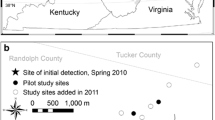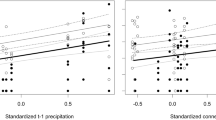Abstract
Geographical variation in population dynamics of a species offers an opportunity to understand the factors determining observed patterns of spatial dynamics. We evaluated the spatial variation in the population dynamics of the pine needle gall midge (PNGM), Thecodiplosis japonensis, which is a severe insect pest in pine forests in Korea, and studied the influences of weather factors that could affect its population dynamics. Results revealed that PNGM population dynamics were classified into five clusters based on the analysis of autocorrelation function and self-organizing map, which is an artificial neural network. We also quantified spatial synchrony in the population dynamics of PNGM using the nonparametric covariance function. Variation in spatial synchrony was strongly related to differences in maximum temperature and precipitation in Random Forest analysis, suggesting that the synchrony in PNGM population dynamics is largely the result of the Moran effect. In addition, spatial differences in population dynamics could be influenced by transient process of synchronization following invasion. Finally, the present results indicate that differences in population dynamics can be induced by interactions among several factors such as maximum temperature, precipitation, and invasion history of species.








Similar content being viewed by others
References
Alhoniemi E, Himberg J, Parhankangas J, Vesanto J (2000) SOM Toolbox (online). http://www.cis.hut.fi/projects/somtoolbox
Bjørnstad ON, Ims RA, Lambin X (1999) Spatial population dynamics: analyzing patterns and processes of population synchrony. Trends Ecol Evol 14:427–432
Bjørnstad ON, Liebhold AM, Johnson DM (2008) Transient synchronization following invasion: revisiting Moran’s model and a case study. Popul Ecol 50(4):379–389
Breiman L (2001) Random Forests. Mach Learn 45:5–32
Buonaccorsi JP, Elkinton JS, Evans SR, Liebhold AM (2001) Measuring and testing for spatial synchrony. Ecology 82:1668–1679
Calle ML, Urrea V (2010) Stability of Random Forest importance measures. Brief Bioinform. doi:10.1093/bib/bbq011
Chon T-S, Park Y-S, Moon K-H, Cha E-Y (1996) Patternizing communities by using an artificial neural network. Ecol Model 90:69–78
Chon T-S, Park Y-S, Kim J-M, Lee B-Y, Chung Y-J, Kim Y (2000) Use of an artificial neural network to predict population dynamics of the forest-pest pine needle gall midge (Diptera: Cecidomyiida). Environ Entomol 29:1208–1215
Chung Y-J, Lee J-H, Lee B-Y (1997) Distribution of pine needle gall midge, Thecodiplosis japonensis Uchida et Inouye (Diptera: Cecidomyiidae), infestation on Japanese red pine, Pinus densiflora S. et Z. Korean J Appl Entomol 36:150–155 (in Korean with English abstract)
Chung Y-J, Park Y-S, Lee B-Y, Chon T-S (1998) Dynamic patterns of the infestation of pine needle gall midge, Thecodiplosis japonensis (Diptera: Cecidomyiidae), in endemic regions of Korea. FRI J Forest Sci 59:64–69
Cooke BJ, Lorenzetti F (2006) The dynamics of forest tent caterpillar outbreaks in Quebec, Canada. For Ecol Manage 226:110–121
Davies DL, Bouldin DW (1979) A cluster separation measure. IEEE Trans Pattern Anal Mach Intel 1:224–227
Estay SA, Lima M, Harrington R (2009) Climate mediated exogenous forcing and synchrony in populations of the oak aphid in the UK. Oikos 118:175–182
Hyams DG (2009) CurveExpert 1.3: a comprehensive curve fitting system for Windows (online). http://s91928265.onlinehome.us/curveexpert/
Ims RA, Steen H (1990) Geographical synchrony in microtine population cycles: a theoretical evaluation of the role of nomadic avian predators. Oikos 57:381–387
Jeon M-J, Choi WI, Choi K-S, Chung Y-J, Shin S-C (2006) Population dynamics of Thecodiplosis japonensis (Diptera: Cecidomyiidae) under influence of parasitism by Inostemma matsutama and Inostemma seoulis (Hymenoptera: Platygastridae). J Asia Pac Entomol 9:269–274
Johnson DM, Liebhold AM, Bjørnstad ON (2006) Geographical variation in the periodicity of gypsy moth outbreaks. Ecography 29:367–374
KFRI (Korea Forest Research Institute) (2005) Annual report of monitoring for forest insect pests and diseases in Korea. SeongMunSa, Seoul
Ko JH (1969) Seasonal trends in the population of larvae of pine gall-midge (Thecodiplosis japonensis Uchida et Inouye) in the spring. J Korean For Soc 9:45–48
Ko JH (1982) The pine gall midge (Thecodiplosis japonensis) in Korea. In: Lee KJ, Lee HP (eds) Proceedings of Korea–USA joint seminar on forest diseases and insect pests. Korea Science and Engineering Foundation and National Science Foundation, USA, Seoul, pp 41–53
Koenig WD (2002) Global patterns of environmental synchrony and the Moran effect. Ecography 25:283–288
Koenig WD, Knops JMH (1998) Testing for spatial autocorrelation in ecological studies. Ecography 21:423–429
Kohonen T (2001) Self-organizing maps. Springer, Berlin
Lee BY, Ko JH, Choi BH, Jeon MJ, Miura T, Hirashima Y (1985) Utilization of proctotrupoid wasps in Korea for control of the pine needle gall midge, Thecodiplosis japonensis (Diptera: Cecidomyiidae). Esakia 23:145–150
Lee BY, Chung YJ, Byung BH, Choi BH (1991) Hazard-rating of pine stands for pine needle gall midge infestation by stand and site variables. Res Report For Res Inst 42:127–134 (in Korean with English abstract)
Lee BY, Chung YJ, Park KN, Byun BH, Bae WI (1997) Distribution of pine needle gall midge, Thecodiplosis japonensis Uchida et Inouye (Diptera: Cecidomyiidae), infestations in Korea: a brief history. FRI J Forest Sci 56:13–20 (in Korean with English abstract)
Liebhold AM, Kamata N (2000) Are population cycles and spatial synchrony a universal characteristics of forest insect populations? Popul Ecol 42:205–209
McCune B, Mefford MJ (1999) Multivariate analysis of ecological data, version 4.25. MjM Software, Gleneden Beach
Mielke EW, Berry KJ, Johnson ES (1976) Multiresponse permutation procedures for a priori classifications. Comm Stat Theo Meth 5:1409–1424
Økland B, Bjørnstad O (2003) Synchrony and geographical variation of the spruce bark beetle (Ips typographus) during a non-epidemic period. Popul Ecol 45:213–219
Park KN, Hyun JS (1983) Studies on the effects of the pine needle gall midge, Thecodiplosis japonensis Uchida et Inouye, on the growth of the red pine, Pinus densiflora Siebold et Zuccarini (I): changes of gall formation rate. J Korean For Soc 61:20–26 (in Korean with English abstract)
Park Y-S, Chung Y-J (2006) Hazard rating of pine trees from a forest insect pest using artificial neural networks. For Ecol Manage 222:222–233
Park Y-S, Chung Y-J, Chon T-S, Lee B-Y, Lee J-H (2001) Interactions between pine needle gall midge, Thecodiplosis japonensis (Diptera: Cecidomyiidae), and its parasitoids in newly invaded areas. Korean J Appl Entomol 40:301–307
Park Y-S, Céréghino R, Compin A, Lek S (2003) Applications of artificial neural networks for patterning and predicting aquatic insect species richness in running waters. Ecol Model 160:265–280
Peltonen M, Liebhold AM, Bjørnstad ON, Williams DW (2002) Spatial synchrony in insect outbreaks: roles of regional stochasticity and dispersal. Ecology 83:3120–3129
Ranta E, Kaitala V, Lindstrdm J, Linden H (1995) Synchrony in population dynamics. Proc R Soc B 262:113–118
Soné K (1987) Population dynamics of the pine needle gall midge, Thecodiplosis japonensis Uchida et Inouye (Diptera, Cecidomyiida). J Appl Entomol 103:386–402
Soné K, Takeda H (1983) Studies on the distribution pattern of the pine needle gall midge, Thecodiplosis japonensis Uchida et Inouye (Diptera, Cecidomyiida) in a pine forest. Res Popul Ecol (Kyoto) 25:336–352
Systat Software Inc (2004) SYSTAT 11. Systat Software, Inc., Richmond
The Mathworks, Inc. (2001) MATLAB version 6.1. The Mathworks, Inc., Massachusetts
Turchin P (1995) Population regulation: old arguments and a new synthesis. In: Cappuccino N, Price PW (eds) Population dynamics: new approaches and synthesis. Academic, San Diego, pp 19–40
Turchin P, Taylor AD (1992) Complex dynamics in ecological time series. Ecology 73:289–305
Turchin P, Lorio PL Jr, Taylor AD, Billings RF (1991) Why do populations of southern pine beetles (Coleoptera: Scolytidae) fluctuate? Environ Entomol 20:401–409
Vesanto J, Himberg J, Alhoniemi E, Parhankangas J (1999) Self-organizing map in Matlab: the SOM Toolbox. In: Proceedings of the MATLAB digital signal processing conference, Espoo, Finland, pp 35–40
Ydenberg R (1987) Nomadic predators and geographic synchrony in microtine population cycles. Oikos 50:270–272
Acknowledgments
We would like to thank Dr. Andrew Liebhold, the editor, for his reviews, comments, and edits to improve the manuscript. We also thank two anonymous reviewers for their valuable comments on an earlier version of this manuscript.
Author information
Authors and Affiliations
Corresponding author
Rights and permissions
About this article
Cite this article
Choi, W.I., Ryoo, M.I., Chung, YJ. et al. Geographical variation in the population dynamics of Thecodiplosis japonensis: causes and effects on spatial synchrony. Popul Ecol 53, 429–439 (2011). https://doi.org/10.1007/s10144-011-0263-8
Received:
Accepted:
Published:
Issue Date:
DOI: https://doi.org/10.1007/s10144-011-0263-8




